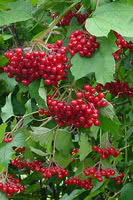Mon-Fri 9am - 5pm Mountain time
Western Snowberry vs Wentworth Highbush Cranberry
Symphoricarpos occidentalis
Viburnum trilobum Wentworth
NOT AVAILABLE THIS SEASON - MIGHT RETURN
NOT AVAILABLE THIS SEASON - MIGHT RETURN
Like the Common Snowberry, the Western Snowberry is a small shrub with pink flowers useful for feeding livestock and preventing erosion. Unlike the common species, however, the Western Snowberry is much more suited to wet conditions, capable of persevering through poor soil drainage and occasional flooding.
After the Snowberry's flowers have bloomed, it produces berries which often last on the plant through winter. These berries are toxic to humans, but livestock and local wildlife love them! Those hoping to attract wildlife to their property can plant Snowberry and expect to see animals foraging on it much later in the year than other plants.
Wentworth Highbush Cranberry is an ample producer that will make you think of the perfect cranberry sauce when you see it. Its huge fruit is delectable in jellies and sauces. In the spring it bears clusters of white flowers, contrasted against green vegetation that turns a rich red in the fall. Magnificent in garden borders or mass planting, you’ll appreciate your cranberry on your table and in your yard.
Western Snowberry Quick Facts
Wentworth Highbush Cranberry Quick Facts
Toxicity: berries are toxic to humans

